It should be smooth sailing ahead for cruise stocks. So far, “Travel demand is off to a strong start, which means availability will continue to shrink in the next couple of months,” said Debbie Haas, vice president of travel for AAA. “So, if you want a specific itinerary, ship or cabin type, act fast or you’ll have to start planning for next year.”
Plus, according to Reuters, travelers have been booking cruises for 2024 at “greater volumes” than even before the pandemic. About 35.7 million consumers are expected to cruise this year alone, up from 31.5 million in 2023.
With demand showing no signs of cooling, the world’s biggest cruise stocks could sail to higher highs. In fact, here are three to buy today.
Royal Caribbean (RCL)

Since bottoming out in late October, Royal Caribbean (NYSE:RCL) sailed from about $80 to a recent high of $138.29. The cruise ship operator recently said its 2024 bookings are outpacing 2019 levels by wide margin, mean RCL could easily see higher highs.
Helping, the company just raised its annual adjusted earnings per share (EPS) by 40 cents to a new range of $9.90 to $10.10 from an earlier forecast of $9.50 to $9.70.
“For 2024, all four quarters and all key products are booked ahead of the same time last year in both rate and volume. Consumer spending for onboard purchases continue to exceed prior years driven by greater participation at higher prices, indicating quality and healthy future demand,” the company added.
Goldman Sachs also added RCL its Conviction List as part of the firm’s “US Conviction List — Directors’ Cut” for April. Macquarie also raised its price target to $160 from $145 with an Outperform rating.
Carnival (CCL)

While Carnival (NYSE:CCL) recently pulled back to $15, it’s starting to pivot from oversold conditions. From here, I’d like to see it initially retest $17.50 and potentially test $19.50 shortly after.
Helping, the company just raised its profit forecast, anticipating a big year for bookings. “The first quarter has been fantastic across the board,” CEO Josh Weinstein said on a post-earnings call, as noted by Reuters. “We delivered record bookings and record customer deposits again this quarter, a great start to the year.”
While the company posted a loss of 17 cents, it was far better than the 55-cent loss a year earlier. Revenue jumped 22% to $5.4 billion, but missed estimates for $5.42 billion. Carnival added that bookings for the rest of the year “continues to be the best on record,” with pricing and occupancy higher than in 2023.
It also guided for a second-quarter loss of three cents, as compared to a year-earlier loss of 31 cents. Plus, it’s seeing full-year earnings of about 98 cents a share. In addition, analysts at Mizuho just initiated coverage of CCL with a buy rating and a price target of $21.
Norwegian Cruise Line (NCLH)

Another one of the hottest cruise stocks to buy is Norwegian Cruise Line (NYSE:NCLH).
After pulling back to $18.56, NCLH is also starting to pivot higher again. Last trading at $19.39, I’d like to see it retest $21.50 initially.
Earnings haven’t been too shabby here either. While its EPS loss of 18 cents missed by four cents, revenues — up about 31% year over year to $1.99 billion — beat by $30 million. Better, the company sees 2024 EPS of $1.23, as compared to estimates for $1.21. It sees adjusted EBITDA of $2.2 billion as compared to estimates for $2.1 billion. And it now sees a profit in the first quarter, instead of a loss.
Norwegian Cruise Line’s Chief Financial Officer Mark Kempa says the company was “more fully booked” than ever before.
Mizuho analysts also initiated coverage with an underperform rating with a $21 price target.
As noted by Investing.com, “The firm’s analysis points to potential growth in the company’s financials for the year 2024, driven by higher-than-anticipated net yields. Despite changes to itineraries in the Red Sea and Middle East, the firm believes Norwegian Cruise Line’s yield guidance for the year appears conservative.”
On the date of publication, Ian Cooper did not hold (either directly or indirectly) any positions in the securities mentioned. The opinions expressed in this article are those of the writer, subject to the InvestorPlace.com Publishing Guidelines.

